From the Magazine: The Mighty Moes
We used to sit around and think about audacious things to do. We found an old atlas and wrote things that hadn’t been done — it was a fun way to spend winter evenings.
Diana Kocornik is on the phone reminiscing about the 1980s in Laramie, Wyoming, and the group of outdoorsy 20-somethings who called it home. Armed with tattered maps and a sense of adventure as wide as the Wyoming sky, that pack of climbers, backpackers, cyclists, paddlers, and alpinists included a pair of blond-haired brothers just a year apart in age who’d grown up leaning into the Laramie wind — Mike and Dan Moe.
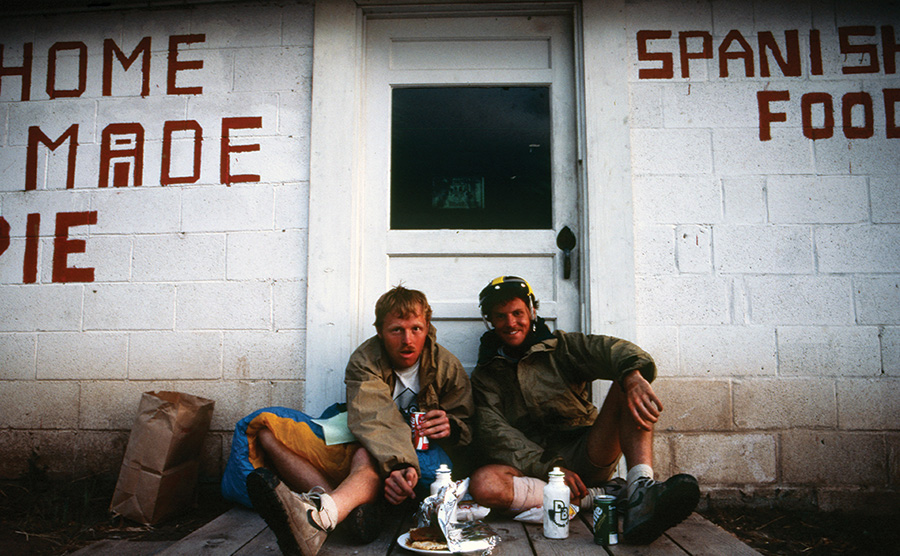
They may have set down roots in Laramie, but passports, journals, and stacks of slides told the truth — the Moes were leaves, gusts propelled them.
“We laughed a lot in those days, we had a lot of fun together, and we loved our weekends,” she said.
Kocornik met the Moe brothers in that audacious time, fell in love with and married Mike a few years later, and had three children with him in between the couple’s adventures together, not least of which was a year in Africa working for CARE to help children in desperately poor conditions.
The line goes quiet as another thought comes to mind.
“Mike would have been 60 this month.”
![]()
Mike and Dan Moe lived an all-American childhood. On the high plains of southeastern Wyoming, the brothers enjoyed an exaggerated version of what we’d today call “free-range parenting.” Want to go to a friend’s house, catch a movie, or spend your allowance on a soda? Get on your bike and go.
“It was Laramie, there’s not a lot going on,” said Mark Jenkins, whose books and “Hard Way” column in Outside magazine recounted many of his exploits growing up and adventuring with his best friend, Mike Moe. “His folks were like my folks, if you got rowdy they said ‘take it outside.’”
Jenkins, Kocornik, the Moes, and other outdoor-obsessed friends formed the Wyoming Alpine Club — “Basically letterhead to help get sponsorship,” Jenkins said — and dreamed of expeditions all over the world while exploring the Snowy Range and Vedauwoo crags in their own backyard. In time, the cadre would attain all sorts of firsts as they built world-class adventuring résumés. The firsts in particular attracted the Moes.
“It’s easy to misunderstand why people want be the first,” said Jenkins, who felt the pull in his journeys as well. “Yes it’s egotistical, but the other thing is you have to figure things out for yourself, something the Moe brothers particularly liked.
“For Mike and Dan, fun really mattered. Their definition of fun was to be out there exploring with a small ‘e.’ Just kind of figuring it out, getting out the maps, getting out the compass, matching the geography to the map and figuring it out your way.”
In 1982, Mike and Dan hiked the Continental Divide from border to border. After that successful trip, the pair hatched what was then a fairly unbelievable plan — next, they’d ride it.
![]()
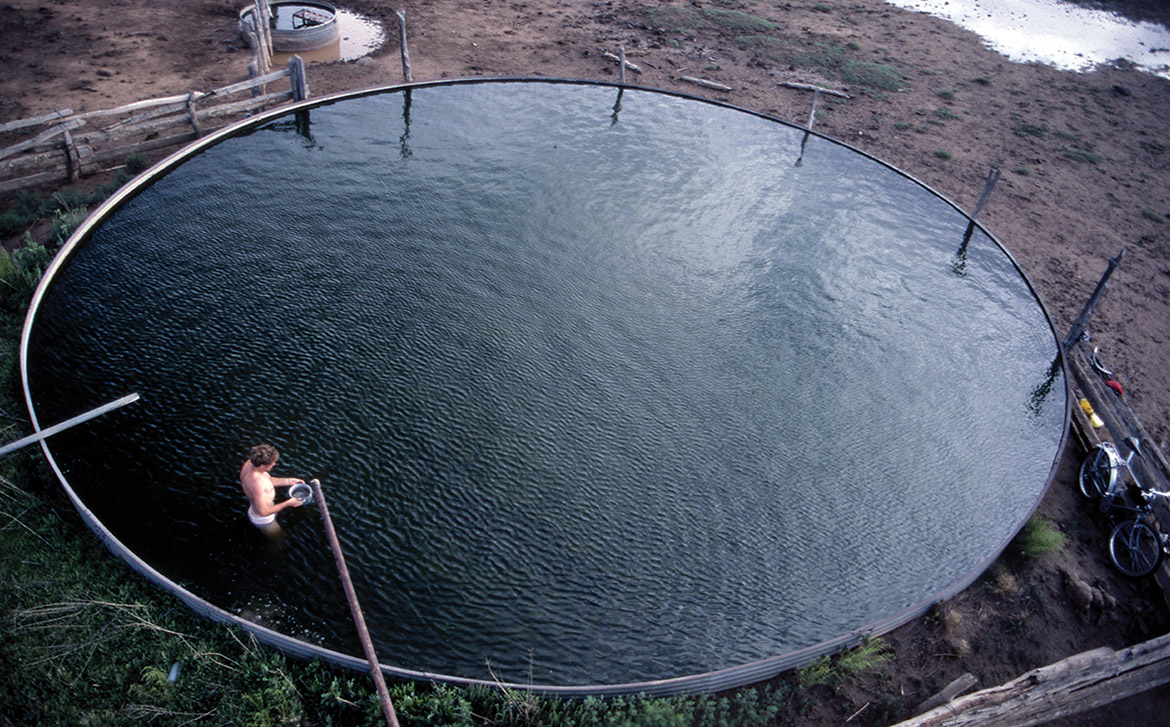
The Moe brothers lit out from the border station at Antelope Wells, New Mexico, on June 24, 1984. Mike was 26, Dan would turn 25 a few weeks later, and for the first time in months, it was pouring rain.
They rode Diamondback Mean Streaks, cutting-edge mountain bikes of the era equipped with cantilever brakes, knobby tires, rigid forks, bullmoose bars, and front and rear racks loaded with full panniers despite the brothers’ deep commitment to traveling light.
You can tell just how hardcore a camper is by what he uses for a washcloth.
“You can tell just how hardcore a camper is by what he uses for a washcloth,” Mike wrote in a journal entry from Independence Day 1984 near Grants, New Mexico. These journal excerpts represent the only published account of their trip, a two-part story in the long-gone Bicycle Rider magazine in 1985. “Some greenhorns burden themselves with an actual washcloth, which pounds the scales at about 1.8 ounces. The more experienced will use a towel shared with the dishes … At the lowest end of the scale are fanatics. As I write this, I’m soaking neck deep in the holding tank of a windmill, watching a sparrow bathing on the far rim. My not-much-cleaner clothes are hanging to dry on a wooden plank behind my head, and my little blue washcloth is swinging with the gentle breeze right next to the other sock.”
Mike, the writer of the pair, logged journal entries. Images, more than a thousand 35mm slides, came from Dan, who shot the trip with a distinct eye toward fulfilling promises to their main sponsor, Diamondback. Dozens, if not hundreds, of the photos show at least one of them smiling in their increasingly less-white Diamondback jerseys. Shots of Mike and Dan together, corroborated by journal entries, are evidence that they lugged a tripod more than 2,000 miles to ensure they got beautiful images.
“Dan was a photographer for the University of Wyoming, so he was a pro,” Jenkins said. “All the big trips, we were always trying to get sponsorship, and you needed to have quality photography.
“It was such a different time. You just planned your trips and you did them — now in the Instagram, facebook, selfie generation, no one does anything without taking a picture of themselves or writing something mid-trip,” said Jenkins, who made a career out of writing about adventure with a clear eye about physical geographies as a proxy for the wanderer’s internal landscape. “There’s beauty in the spontaneity and instant gratification of it, but you lose the ability to reflect on what you’re doing.
“Dan and Mike weren’t immune to it [the lure of publicity]. They wanted to sell their story. They were motivated by many things.”
By July 9, the Moes had reached Colorado, whose high country the pair called the “epitome of the Continental Divide.” While the midsummer snow fields meant no more catering their daily route finding to the availability of windmills and the water they pumped, leaving the high desert for high peaks meant the brothers found themselves alongside their bikes as often as astride them.
What will the next group of hikers think of the narrow bike tracks across the steep snow?
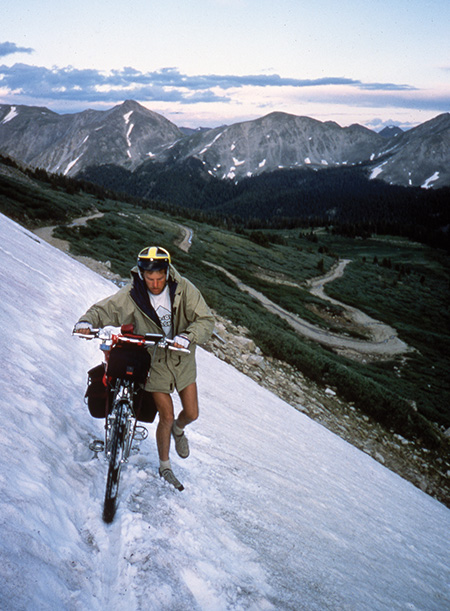
“July 18, Tincup Pass: A steep snowfield still blocks the Jeep road over the top of Tincup Pass. The snow drops away at a 35 percent angle to the valley floor, so Dan and I set our tires in the footprints of previous hikers and carefully traverse the snow, kicking steps for our own path. Once across, we have to look back and laugh: What will the next group of hikers think of the narrow bike tracks across the steep snow?”
A week later on the Blue Ridge Trail near today’s Great Divide Mountain Bike Route in central Colorado, the pair — along with sisters Andrea and Nancy Sharp, who joined the Moes for a week — ferried gear up a steep section of ridgeline, “joking about the Divide wearing out our Nikes before our tires.”
By July 29, Mike and Dan were flying downhill out of the Sierra Madres when they rode past a battered sign marking the Wyoming border.
They were close to home now, but 1,200 miles still lay in front of them, not least of which would be the shifting sands of Wyoming’s Red Desert.
![]()
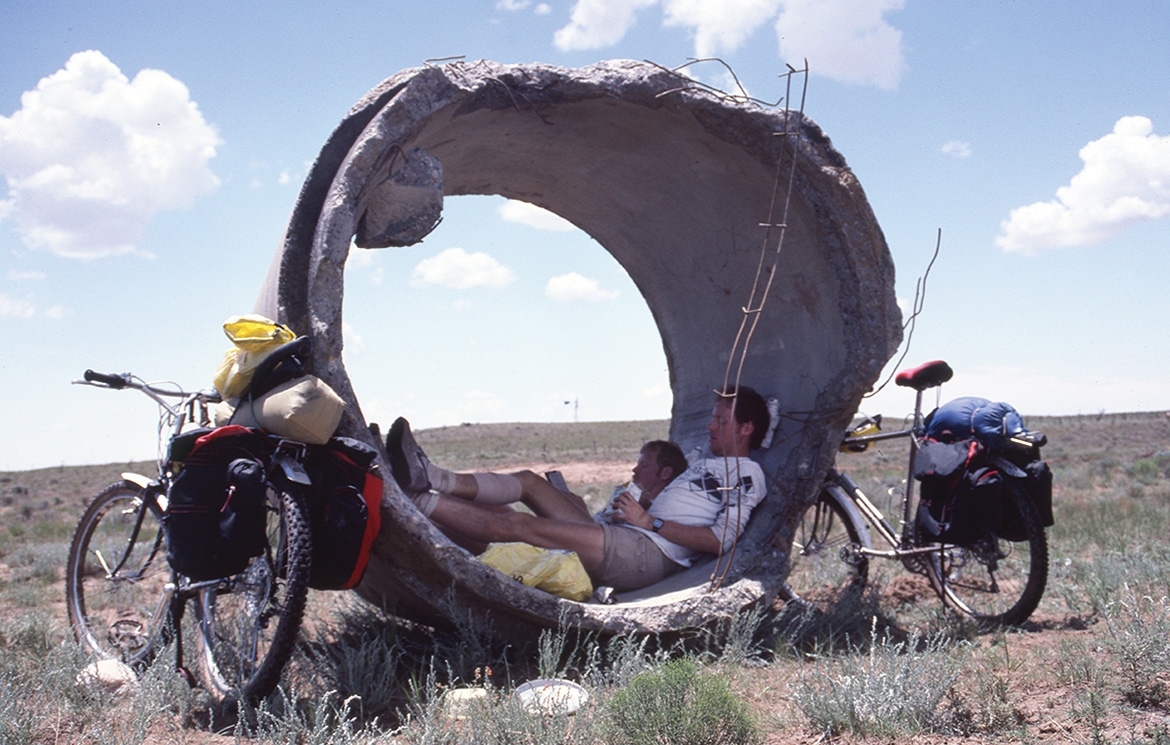
Kocornik remembered that for two men so driven, so close in age, and so bold, Mike and Dan lacked any competitive impulses to one-up the other, instead viewing their adventures as a chance to bring others into the wild.
“A lot of these big trips were really social things. Mike would never do an expedition by himself. It was as much about the social as about the trip,” she said. “Dan was also a very patient teacher of outdoor skills. Not a whole lot of people who operated on their level. They would take people who weren’t as accomplished and train them.”
But with the exception of the Sharp sisters joining for a week, the Divide ride was a Moe-only affair.
“Mike really liked doing adventures with his brother,” Jenkins said when asked why he didn’t join his friends on the trip, especially since he’d been bicycle touring for a decade by then and would head to the USSR a few years later for a pioneering ride across Siberia. “They wanted it to be a Moe Brothers Adventure. This one was very much a journey of brotherhood.”
![]()
“The mountains are starting to look familiar,” Mike wrote on July 30. “Even though we haven’t previously followed this trail, this is our terrain and our general stomping grounds. We put an extra push in every pedal stroke, like a dog pulling at the leash when the walk turns toward home.”
The Great Divide Basin lay in wait, a section of Continental Divide country that proves a challenge for every rider who has passed through. A self-contained basin, any rain that falls here stays put, at least until the relentless wind scrapes it away.
As on today’s route, the Moes wended their way from Rawlins to South Pass City where the Wind River Mountains rear up from the desert and riders enter the Greater Yellowstone ecosystem and point into a pair of national parks.
“The last few hours have been real white-knuckle stuff,” Mike wrote on August 11, but not because of rocky trails or steep drops.
“We’ve been on pavement since yesterday, because park regulations in both Yellowstone and Teton prohibit backcountry biking … several times we were forced to bail off the narrow roads, thankful for the extra control offered by knobby tires.”
Soon the pair hit Montana, logging a brutal 13-hour day in the mountains southwest of Dillon, 28 miles that “rates as one of the most beautiful — and one of the hardest — of the entire trip,” only to discover upon arrival at camp that Mike’s sleeping bag had slipped off somewhere in the dark. “Another typically easy day on the Divide,” they cracked as they walked back into camp after a successful search … at 3:00 am.
By August 20, the Moes were on the home stretch, but their route first took them around the Anaconda-Pintler Wilderness near Butte, Montana. They followed roads, then trails, then simply waded through lakes of grass until after dark and they set up camp in a stand of pines.
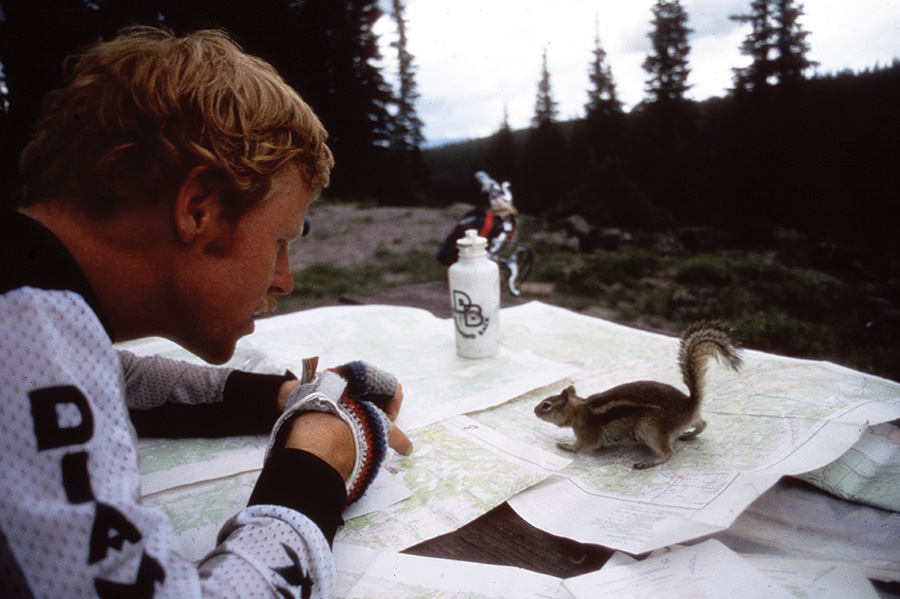
“We feel totally alone in the woods, as if we are pioneers exploring new and untamed country. Though Dan and I have always loved the wilds, never in the past has the great breadth of the land seemed so appealing, and so much an important part of our lives. Surely, this is the most moving and exhilarating night of the trip.”
The magic of the spot and the moment couldn’t suppress the pair’s lighthearted camaraderie, steeled by this adventure and dozens past.
Mike continued:
“I am just beginning to drift off to sleep when Dan asks earnestly, ‘Don’t you think we’d better lock up the bikes?’ We laugh so hard our jaws hurt.”
Eight days later, Mike and Dan rose at dawn near Glacier National Park having realized the night before that a final Herculean push could get them to Canada by day’s end. Smoke clouded the sky, nearly obscuring Chief Mountain’s bulk standing sentinel over the plains east of Glacier, and the brothers hammered all the way to the finish “like we’re riding 19-pound racers.”
Arms aloft, Mike and Dan Moe rolled into Canada two months to the day after leaving the Mexican border.
“For Dan and me, this is the end of one very special dream, but the beginning of many others.”
![]()
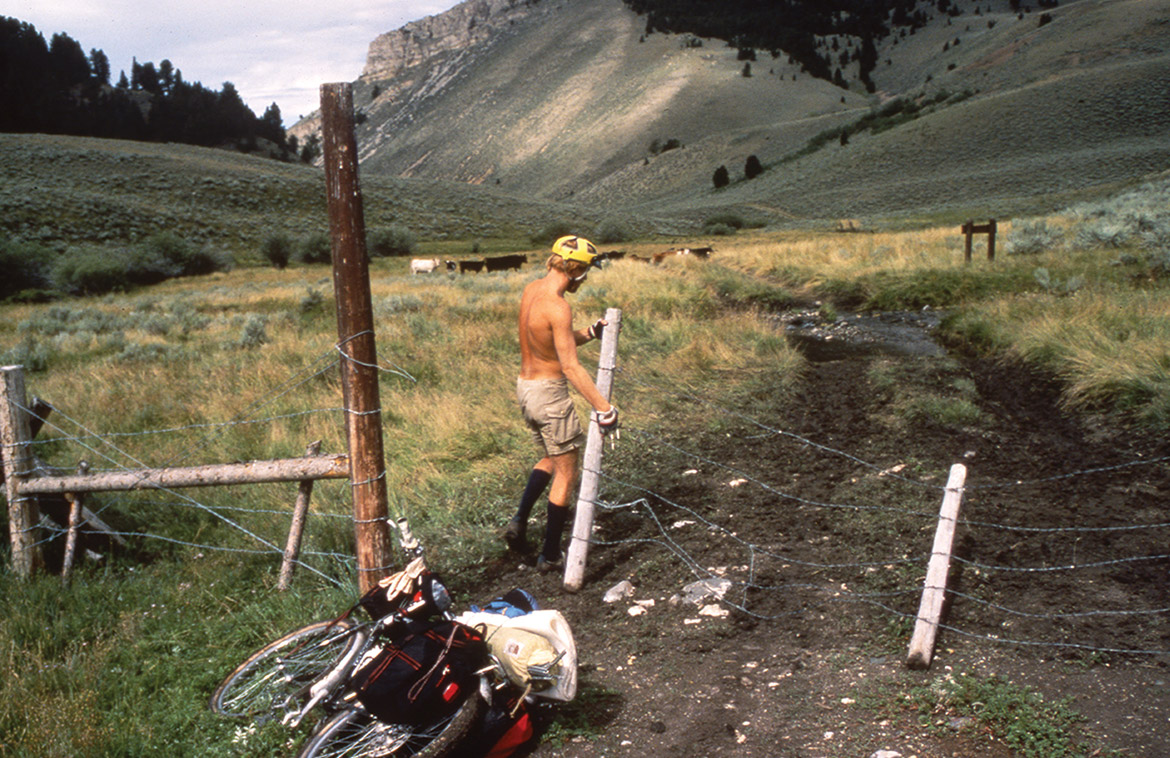
For the next 10 years, Mike and Dan continued to explore by bike, kayak, and on foot. Dan rode across Australia in 1987, Mike joined Jenkins for a first descent of the Niger River in West Africa in 1991, and in 1995 the brothers dreamed up a trip to the Barnes Ice Cap — “Ocean to Icecap” on Canada’s remote Baffin Island.
Their team rode mountain bikes across the cap, the first to do so. At the trip’s end, Mike and Dan, along with expedition members and fellow Laramie residents Sharon Kava and Brad Humphrey, were en route back to a village in a small, open boat they’d chartered. A bowhead whale surfaced under the craft, flipping it into the Arctic waters.
All but the boat’s Inuit captain, who was wearing a marine survival suit, succumbed to the killing cold. Mike was 37, Dan was 36.
![]()
The wind in southeast Wyoming is born along the Great Divide, running hard out of the mountains to scour the little college town of Laramie. High in those mountains in the summer of 1984, Mike and Dan stopped at the Colorado-Wyoming line to celebrate their adventure’s advance even as they lamented that they’d only just begun to explore Colorado. Eating lunch at the edge of his home state, still upwind of so much, Mike wrote what could’ve been the journey’s motto — or the brothers’ epitaph:
The more you know of the mountains, the more you find of them there is to know.
Editor’s Note
I am indebted to the generosity of time and spirit from the people Mike and Dan left behind. The pair’s sister, Terry Moe, recovered more than 1,000 slides and provided them to this magazine without hesitation. Mike’s son Kevin met me in a Helena, Montana, café with binders full of images and shared his memories of a man who passed when he was only a year old. Kevin was preparing for a trip to Hawaii where he planned to paddle the length of the archipelago. The apple and the tree, as they say. Diana Kocornik spoke at length and with great clarity and honesty about her late husband. And Mark Jenkins gamely discussed his late best friend. His final Hard Way column in Outside, “Above and Beyond,” is mandatory reading. The Moe family wouldn’t accept payment for the images shown here, so to help preserve the legacy of Dan and Mike’s 1984 achievement, we’re digitizing the collection for donation to the University of Wyoming library in hopes it will remain available for all who are curious about the accomplishments of these true adventure cyclists. –AS
This feature originally appeared in the May 2018 issue of Adventure Cyclist magazine.

